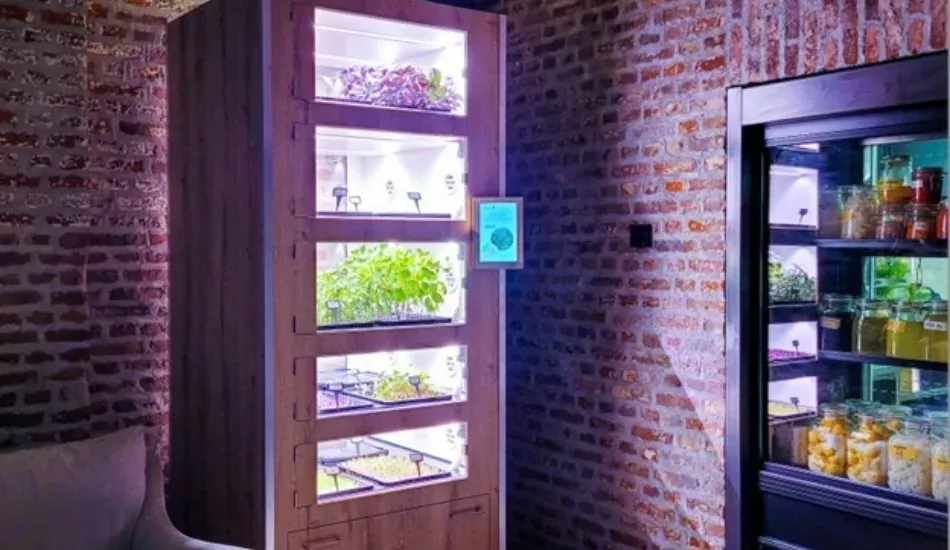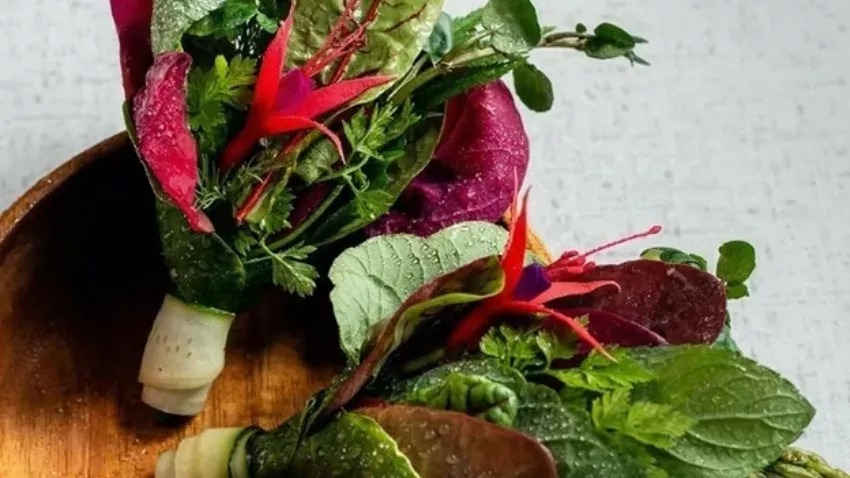In VaVersa's miniature greenhouse, chefs can grow their own herbs and vegetables on site. Ultra-local production in restaurants benefits both taste and environmental impact, the Amsterdam start-up believes.
Credit: VaVersa

New to the world of plants is not Olivier Francescangeli. In Wageningen, he studied plant sciences. While specializing in greenhouse horticulture, he became inspired by companies that do not cultivate horizontally, but vertically. "It saves a lot of space and the closed environment makes it easier to control the growing process. And it can be done anywhere, allowing food to be grown wherever it is eaten."
With that idea, he founded his company VaVersa. The entrepreneur developed the Mia, a miniature greenhouse for vegetables and herbs. Several Dutch restaurants and corporate canteens already have one. "Food trends often start in professional kitchens and are created by chefs. So the professional kitchen seemed a logical place for me."
Ultralocal
The bulk of food chains are long. Francescangeli: "It takes a while for products to reach their final destination. This is not beneficial. When products travel, they lose water and flavor. The quality decreases." He wants to solve that problem with the small greenhouses. "The Mia makes it possible to harvest herbs and serve them just a few seconds later. As a result, the plants contain about 40 percent more nutrients and taste better. For cooks, this is interesting: they consider taste the most important thing."
The miniature greenhouse can grow herbs, cresses, leafy vegetables, lettuce varieties and edible flowers. "These can be common herbs like basil and mint, but also exclusive spices or beautiful flowers that can be eaten. Thus, the Mia can bring new flavors and be a culinary tool."
Mia Gains
The miniature greenhouses also provide environmental benefits, according to the entrepreneur. "That's in the fact that a lot of transport kilometers are eliminated. And it saves a lot of packaging material." The greenhouse also combats food waste. "Herbs that are ordered and delivered in bags have a very limited shelf life. In the greenhouse, plants not only stay good, they actually continue to grow. Cooks can cut off what they need on the spot and not have to throw anything away."
The Amsterdam start-up claims growing from their greenhouse saves land and water. "The environment is controlled and gives plants the ideal conditions to grow. As a result, production per square meter is five times higher than the case with an open field. And 90 percent less water is needed."
Energy consumption
.Although, of course, the greenhouse does use energy. "That's in the special lamps, the water system and sensors that record the climate in the greenhouse. But the system is very efficient."

Green fingers?
Is it realistic to transform cooks into growers? Francescangeli says it is. "Basically, the greenhouse does all the work. Of course there are some human actions needed, think of seeding and refilling the water tank. In a week, this takes 30 to 45 minutes. Chefs don't need an extremely green thumb for it. We give a short training session and explain how everything works. Then the kitchen staff can do it themselves. If there are questions, we watch them remotely."
Subscription basis
.The Mia is not for sale, but can be used on a subscription basis. "Hospitality establishments can rent it and pay a fixed amount per month. VaVersa takes care of everything, from the seeds for the plants to advice on how to incorporate the harvest into the menu."
The business case depends on which plants are grown. "Some herbs can already be purchased for a low amount. This is due to mass production and cheap labor in other countries. When catering staff grow their own edible flowers or mini-vegetables such as radishes and broccoli, the savings are already much greater. But it's about more than money. For many chefs, the biggest gain is the improved taste and the sustainable component."
From starred restaurants to corporate canteens
.The miniature greenhouse is now in various Dutch catering establishments: from Michelin-starred restaurants to company canteens. The segment is deliberately kept broad, Francescangeli said. "Places for fine dining might be obvious, but we look much wider than that. For example, we have put away greenhouses in the corporate canteens of Unilever, Booking and Uber. Those are big restaurants where a lot of people eat every day. We also work together with Radboudumc and Van der Valk Hotels. We certainly don't want to make the concept too exclusive. The more chefs use it, the better that is."
VaVersa also wants to eventually operate its Mia abroad, starting with Belgium, France and Germany. To that end, the company has just launched a new funding campaign. There should also be new versions of the current model. "More compact, so we can also deliver to smaller business. Some companies want to, but simply do not have the space to put the Mia down."
Pontificating in the restaurant
.The greenhouse in most restaurants is not in the kitchen, but in the business itself. "That's what we designed it for. We want the Mia to stand pontifically in the restaurant. That's why we put a lot of time into the design. Experience shows that guests are curious about the greenhouse anyway and start asking questions about it. Often people who come to eat don't realize where the products on their plates come from and the environmental impact that entails. The miniature greenhouses can start the conversation about that, in the hope that people are at least aware of it."
Source: change.inc